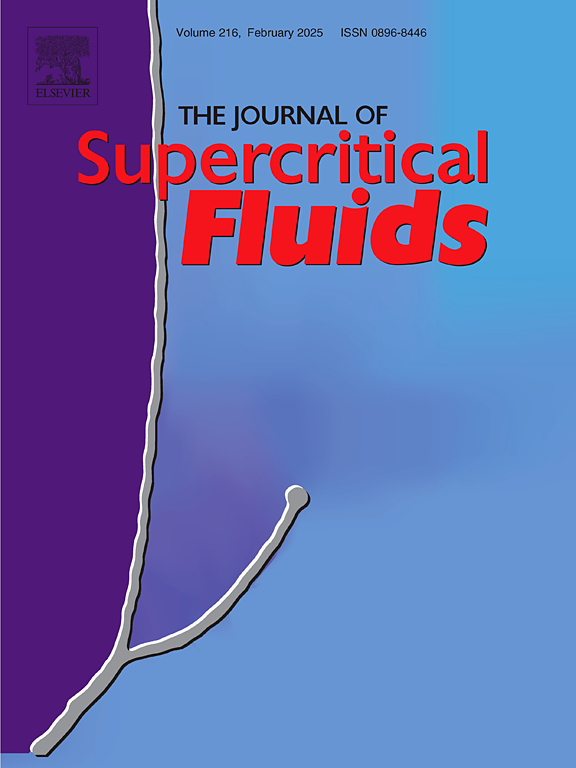Extraction and isomerization of ultraviolet-absorbing substances, saclipins, from an edible cyanobacterium Aphanothece sacrum using subcritical water
IF 3.4
3区 工程技术
Q2 CHEMISTRY, PHYSICAL
引用次数: 0
Abstract
The effects of the extraction conditions on the recovery and isomerization of the UV-absorbing saclipins from the edible cyanobacterium Aphanothece sacrum by subcritical water were investigated. The extraction temperature (100–160 ℃) did not affect the extraction efficiency of saclipins, but the pressure (5–15 MPa) had a significant effect. The saclipin B (cis-configuration) ratio in the extract increased with extraction temperature. Since saclipin A (trans-configuration) is predominant in the raw material, it is proposed that thermal-induced cis-isomerization occurs during the extraction process under elevated temperature conditions. Furthermore, we found that extraction with subcritical water resulted in higher extraction and isomerization efficiencies of saclipins than extraction with organic solvents. Extracts obtained by subcritical water extraction (SWE) exhibited antioxidant and anti-elastase activities and the degree of the activities was affected by the extraction temperature (i.e., saclipin isomer ratio). These findings could facilitate the development of sunscreens with enhanced skincare benefits, utilizing naturally-derived bioactive compounds.
利用亚临界水从可食用蓝藻 Aphanothece sacrum 中提取紫外线吸收物质--囊脂素并将其异构化
研究了亚临界水萃取条件对食用蓝藻中吸收紫外线的囊脂素的回收和异构化的影响。萃取温度(100-160 ℃)不影响糖脂苷的萃取效率,但压力(5-15 MPa)有显著影响。提取物中糖脂 B(顺式构型)的比例随提取温度的升高而增加。由于原料中主要是糖脂素 A(反式构型),因此推测在高温条件下的提取过程中会发生热诱导的顺式异构化。此外,我们还发现用亚临界水萃取比用有机溶剂萃取糖脂苷的萃取率和异构化效率更高。通过亚临界水萃取(SWE)获得的提取物具有抗氧化和抗弹性蛋白酶活性,且活性程度受萃取温度(即糖脂异构体比率)的影响。这些发现有助于利用天然萃取的生物活性化合物开发出具有更强护肤功效的防晒霜。
本文章由计算机程序翻译,如有差异,请以英文原文为准。
求助全文
约1分钟内获得全文
求助全文
来源期刊

Journal of Supercritical Fluids
工程技术-工程:化工
CiteScore
7.60
自引率
10.30%
发文量
236
审稿时长
56 days
期刊介绍:
The Journal of Supercritical Fluids is an international journal devoted to the fundamental and applied aspects of supercritical fluids and processes. Its aim is to provide a focused platform for academic and industrial researchers to report their findings and to have ready access to the advances in this rapidly growing field. Its coverage is multidisciplinary and includes both basic and applied topics.
Thermodynamics and phase equilibria, reaction kinetics and rate processes, thermal and transport properties, and all topics related to processing such as separations (extraction, fractionation, purification, chromatography) nucleation and impregnation are within the scope. Accounts of specific engineering applications such as those encountered in food, fuel, natural products, minerals, pharmaceuticals and polymer industries are included. Topics related to high pressure equipment design, analytical techniques, sensors, and process control methodologies are also within the scope of the journal.
 求助内容:
求助内容: 应助结果提醒方式:
应助结果提醒方式:


